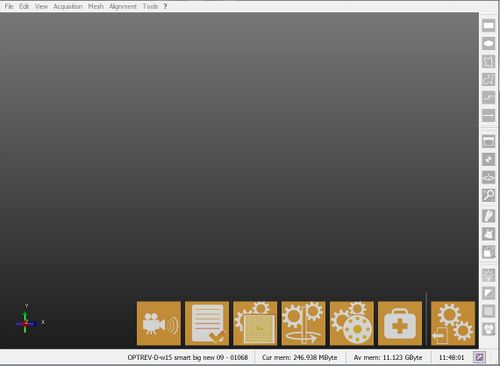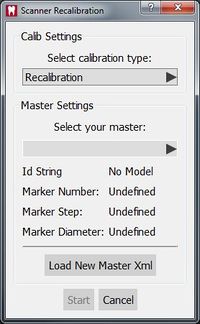Difference between revisions of "Dental Service Tools"
(Aggiornamento a 3.0 (Nuova organizzazione service mode)) |
|||
| Line 1: | Line 1: | ||
{{Language bar}} | {{Language bar}} | ||
| − | {{DISPLAYTITLE:Dental Service | + | {{DISPLAYTITLE:Dental Service Mode|noerror}} |
<translate> | <translate> | ||
| − | + | <!--T:2--> | |
| + | __TOC__ | ||
| + | |||
| + | OpticalRevEng Dental offers a Service Mode that can be started from the [[Support_Toolbars_And_Menus#Tools|Tools Menu]], to recalibrate and diagnose any issue that might occur. | ||
| + | |||
| + | {{Screenshot|Service-mode.jpg}} | ||
| + | |||
| + | == Live Mode == | ||
| + | |||
| + | With this tool you can check what the scanner cameras are seeing. | ||
| + | |||
| + | You can start this tool with this {{Inline button|ActionLiveCameraParams.svg}} button; | ||
| + | |||
| + | == Check Scanner == | ||
| + | |||
| + | The software will check the scanner connection every time it starts. | ||
| + | |||
| + | With this tool {{Inline button|actionCheckScannerHardware.svg}} you can do this check manually. | ||
| + | |||
| + | == Recalibrate Head== <!--T:3--> | ||
| − | + | You can start this tool clicking this {{Inline button|actionRecalibrateHead.svg}} button; | |
| − | |||
| − | + | There are 2 types of calibration: | |
| + | ; Recalibration : Fast procedure useful to do periodically or if the scanner is moved | ||
| + | ; Full Calibration : More complex procedure useful if the scanner is returning from a mechanical repair | ||
<!--T:4--> | <!--T:4--> | ||
| Line 14: | Line 34: | ||
<!--T:5--> | <!--T:5--> | ||
#Put the calibration kit inside the scanner in the correct position | #Put the calibration kit inside the scanner in the correct position | ||
| − | # | + | #Select the calibration type from the drop-down menu |
#In the calibration dialog, select from the drop down menu the exact calibration kit name | #In the calibration dialog, select from the drop down menu the exact calibration kit name | ||
#Click '''Start''' | #Click '''Start''' | ||
| Line 22: | Line 42: | ||
<!--T:7--> | <!--T:7--> | ||
| − | {{Small image| | + | {{Small image|Calib-dlg.jpg}} |
<!--T:8--> | <!--T:8--> | ||
| Line 33: | Line 53: | ||
<!--T:10--> | <!--T:10--> | ||
| − | If the calibration was successful, the ''' | + | If the calibration was successful, the '''Axes Calibration''' starts automatically. |
==Recalibrate Axis== <!--T:11--> | ==Recalibrate Axis== <!--T:11--> | ||
| Line 40: | Line 60: | ||
This tool is used to check the movement system of the scanner. The scanner will scan an object, analyze it, and use this data to calibrate the movement system. | This tool is used to check the movement system of the scanner. The scanner will scan an object, analyze it, and use this data to calibrate the movement system. | ||
| − | + | This tool will start automatically after a '''Head Recalibration''' or can be started manually with the {{Inline button|actionDirectAxesCalib.svg}} button. | |
| − | When the '''Dynamic Articulation Module'''is enabled, calibrate the axis with the specific [[Accessories|Axis Calibration Object]]. From that moment on, any recalibration needs to be performed with the same object. Otherwise, axis recalibration will fail. | + | |
| + | <!--T:13--> | ||
| + | {{Important|When the '''Dynamic Articulation Module''' is enabled, calibrate the axis with the specific [[Accessories|Axis Calibration Object]]. From that moment on, any recalibration needs to be performed with the same object. Otherwise, axis recalibration will fail.}} | ||
<!--T:14--> | <!--T:14--> | ||
| Line 63: | Line 85: | ||
# Clean the multi-die from excessive material or white powder, every single die position needs to be clearly separated from the others | # Clean the multi-die from excessive material or white powder, every single die position needs to be clearly separated from the others | ||
# Put the empty multi-die support inside the scanner | # Put the empty multi-die support inside the scanner | ||
| − | # | + | # Start the tool with this {{Inline button|ActionAutoSetUpMultiDieParameters.svg }} button |
# Click '''Ok''' when prompted | # Click '''Ok''' when prompted | ||
| Line 69: | Line 91: | ||
<!--T:21--> | <!--T:21--> | ||
| − | When doubting the proper functioning of the scanner, this tool carries out a specific acquisition of the object currently inside the scanner | + | When doubting the proper functioning of the scanner, this tool carries out a specific acquisition of the object currently inside the scanner. |
| + | |||
| + | The software then saves all the information in a "*.diag" file that can be sent to the OpticalRevEng Dental support to diagnose possible issues. | ||
| + | |||
| + | To start this tool click this {{Inline button|actionDiagnosticAcquisition.svg}} button. | ||
</translate> | </translate> | ||
{{Navigation|Dental_Options_Interactor|Main Page}} | {{Navigation|Dental_Options_Interactor|Main Page}} | ||
Revision as of 13:17, 27 November 2015
Contents
OpticalRevEng Dental offers a Service Mode that can be started from the Tools Menu, to recalibrate and diagnose any issue that might occur.
Live Mode
With this tool you can check what the scanner cameras are seeing.
You can start this tool with this button;
Check Scanner
The software will check the scanner connection every time it starts.
With this tool you can do this check manually.
Recalibrate Head
You can start this tool clicking this button;
There are 2 types of calibration:
- Recalibration
- Fast procedure useful to do periodically or if the scanner is moved
- Full Calibration
- More complex procedure useful if the scanner is returning from a mechanical repair
This tool uses the Calibration Kit to carry out a new calibration of the Optical Head of the scanner. The procedure is the following:
- Put the calibration kit inside the scanner in the correct position
- Select the calibration type from the drop-down menu
- In the calibration dialog, select from the drop down menu the exact calibration kit name
- Click Start
If the calibration kit name is not available in the drop down menu, the Load New Master Xml button can be used to add a new calibration kit from the appropriate Xml description file.
The calibration procedure is automatic. Once finished, the software will show one of the following messages:
- 'Scanner Already Calibrated' : the calibration is not necessary
- 'Scanner Recalibrated Successfully' : the calibration has been completed
- 'Scanner Recalibration Failed' : calibration has to be repeated
If the calibration was successful, the Axes Calibration starts automatically.
Recalibrate Axis
This tool is used to check the movement system of the scanner. The scanner will scan an object, analyze it, and use this data to calibrate the movement system.
This tool will start automatically after a Head Recalibration or can be started manually with the button.
- Put the calibration object inside the scanner
- Click Recalibrate Axis
- Click Ok when prompted
The calibration procedure is automatic. Once it is finished, the software will show one of the following messages:
- 'Axis Recalibration Successfull' : the calibration has been completed
- 'Axis Recalibration Failed' : calibration has to be repeated
Auto Set-Up Multi-Die Parameters
This tool is used to calibrate the Multi-Die support. If the acquisitions carried out with the Multi-Die are not correctly recognized, the calibration procedure is the following:
- Clean the multi-die from excessive material or white powder, every single die position needs to be clearly separated from the others
- Put the empty multi-die support inside the scanner
- Start the tool with this
button
- Click Ok when prompted
Diagnostic Acquisition
When doubting the proper functioning of the scanner, this tool carries out a specific acquisition of the object currently inside the scanner.
The software then saves all the information in a "*.diag" file that can be sent to the OpticalRevEng Dental support to diagnose possible issues.




